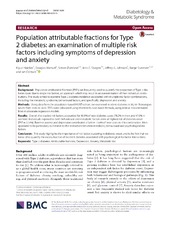| dc.contributor.author | Naicker, Kiyuri | |
| dc.contributor.author | Manuel, Douglas | |
| dc.contributor.author | Øverland, Simon Nygaard | |
| dc.contributor.author | Skogen, Jens Christoffer | |
| dc.contributor.author | Johnson, Jeffrey A | |
| dc.contributor.author | Sivertsen, Børge | |
| dc.contributor.author | Colman, Ian | |
| dc.date.accessioned | 2019-04-16T11:19:44Z | |
| dc.date.available | 2019-04-16T11:19:44Z | |
| dc.date.issued | 2018-11-22 | |
| dc.Published | Naicker K, Manuel D, Øverland SØ, Skogen JC, Johnson JA, Sivertsen BS, Colman I. Population attributable fractions for Type 2 diabetes: an examination of multiple risk factors including symptoms of depression and anxiety. Diabetology and Metabolic Syndrome. 2018;10:84 | eng |
| dc.identifier.issn | 1758-5996 | |
| dc.identifier.uri | https://hdl.handle.net/1956/19356 | |
| dc.description.abstract | Background: Population attributable fractions (PAFs) are frequently used to quantify the proportion of Type 2 diabetes cases due to single risk factors, an approach which may result in an overestimation of their individual contributions. This study aimed to examine Type 2 diabetes incidence associated with multiple risk factor combinations, including the metabolic syndrome, behavioural factors, and specifically, depression and anxiety. Methods: Using data from the population-based HUNT cohort, we examined incident diabetes in 36,161 Norwegian adults from 1995 to 2008. PAFs were calculated using Miettinen’s case-based formula, using relative risks estimated from multivariate regression models. Results: Overall, the studied risk factors accounted for 50.5% of new diabetes cases (78.2% in men and 47.0% in women). Individuals exposed to both behavioural and metabolic factors were at highest risk of diabetes onset (PAF = 22.9%). Baseline anxiety and depression contributed a further 13.6% of new cases to this combination. Men appeared to be particularly vulnerable to the interaction between metabolic, behavioural and psychological risk factors. Conclusion: This study highlights the importance of risk factor clustering in diabetes onset, and is the first that we know of to quantify the excess fraction of incident diabetes associated with psychological risk factor interactions. | en_US |
| dc.language.iso | eng | eng |
| dc.publisher | BioMed Central | eng |
| dc.relation.uri | https://dmsjournal.biomedcentral.com/track/pdf/10.1186/s13098-018-0387-5 | |
| dc.rights | Attribution CC BY | eng |
| dc.rights.uri | http://creativecommons.org/licenses/by/4.0/ | eng |
| dc.subject | Type 2 diabetes | eng |
| dc.subject | Attributable fractions | eng |
| dc.subject | Depression | eng |
| dc.subject | Anxiety | eng |
| dc.subject | Metabolic risk | eng |
| dc.title | Population attributable fractions for Type 2 diabetes: an examination of multiple risk factors including symptoms of depression and anxiety | eng |
| dc.type | Peer reviewed | |
| dc.type | Journal article | |
| dc.date.updated | 2018-12-11T14:48:28Z | |
| dc.description.version | publishedVersion | |
| dc.rights.holder | Copyright 2018 The Authors | eng |
| dc.identifier.doi | https://doi.org/10.1186/s13098-018-0387-5 | |
| dc.identifier.cristin | 1641823 | |
| dc.source.journal | Diabetology and Metabolic Syndrome | |

